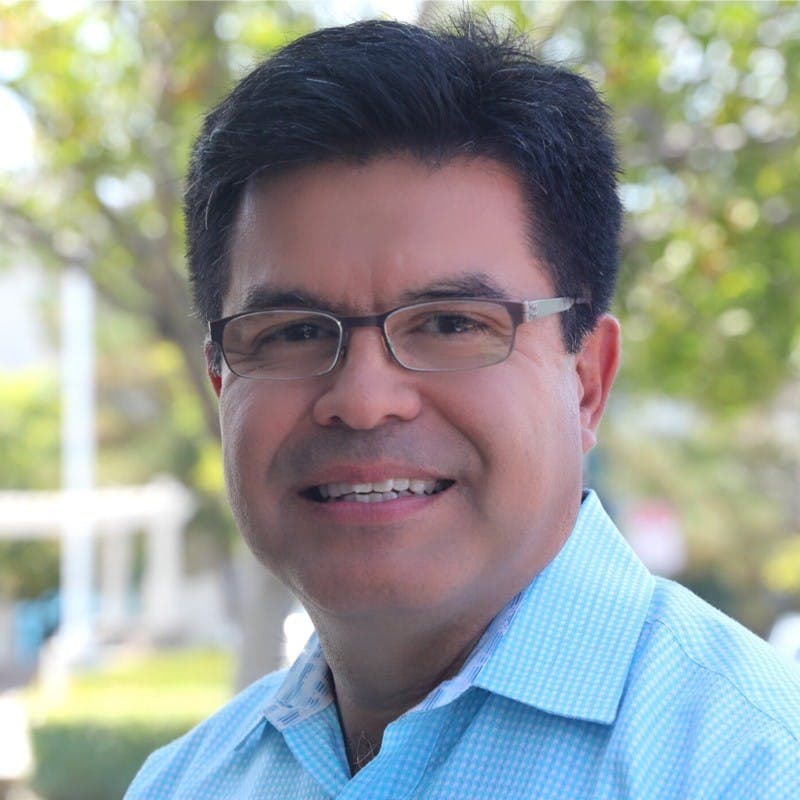How to Nail “Tell Me About a Time…” Interview Questions
One of the most common types of behavioral interview questions is, "Tell me about a time..." Here's how to answer these, from an expert coach with years of experience helping applicants nail their interviews.

By Jose O.
Posted June 13, 2025

Join a free event
Learn from top coaches and industry experts in live, interactive sessions you can join for free.
Table of Contents
Job interviews can be daunting, especially when you’re faced with behavioral questions like, "Tell me about a time..." that are hard to predict and prepare for ahead of time. These questions–designed to gauge your past experiences and behaviors, and how they reflect the company’s values and culture–require careful preparation and effective storytelling.
Leveraging structured interview techniques like STAR (Situation, Task, Action, Result) can help you ace these questions and stand out as a top candidate.
I’ve helped numerous strong candidates prepare for interviews, particularly focusing on behavioral questions and these are some of my top tips for success. By using the STAR method, I've enabled candidates to prepare compelling stories that truly showcase their skills. Through mock interviews and tailored feedback, they have progressed to the next interview stage with confidence, armed with structured and impactful responses that set them apart as top contenders. Let’s dive in!
The STAR Method
What is the STAR Method?
The STAR method is a popular structured approach to answering behavioral interview questions by outlining the Situation, Task, Action, and Result of a particular experience. When preparing for interviews, identify specific examples from your past that align with key competencies, values, and culture match required for the role.
- Situation: Describe the context of the scenario you're about to discuss. Provide relevant details about the setting, stakeholders involved, and any challenges you faced.
- Task: Explain the specific goal or objective you were working towards in the given situation. What were you responsible for accomplishing?
- Action: Detail the actions you took to address the situation and accomplish the task. Highlight your skills, strengths, and decision-making process during this phase.
- Result: Share the outcome of your actions and the impact they had on the situation or organization. Quantify your achievements whenever possible and reflect on any lessons learned.
Why the STAR Method is Useful for Interview Questions
This method is not only useful for behavioral “Tell me about a time…” questions. You can leverage it at any time of the interview process to make a memorable experience and stand out to the interviewer. The interviewer may not remember that you “managed a digital marketing campaign during COVID,” but they will definitely remember the story you tell of the challenge, ups and downs, sweat and tears, and final successful conclusion of your “50% increase in pipeline COVID campaign.”
In other words, the STAR method takes your already powerful anecdotes and organizes them in such a way that they are easily understood and remembered by your interviewer.
How to Use the STAR Method Effectively
To really take advantage of this method, you have to build a portfolio of at least four to five success stories from your past experiences that match the best with the job description requirements and the values of the company that is interviewing you. There is no point in building a story around a great accomplishment if it has absolutely nothing to do with the role you’re applying for.
Each of the examples also has to have both quantitative and qualitative results. Some companies even ask for examples where the result was disappointing, as they want to understand how you deal with failure, and how you leverage the learnings from the experience in your future projects.
To start preparing for your interview using the STAR method…
- Review the job description, the company’s website, and other applicable information.
- Start brainstorming potentially applicable past successes. In the beginning, don’t think too much about it. Try to get as many ideas for examples as possible down on paper.
- Once you have a list, narrow it down to the top five stories. Generally, you want to choose the ones that led to the greatest impact, overcame the hardest challenges, or showed the most personal growth.
- Write the details of the story in the STAR framework: situation (context), task (goal), action (what did you do?), and result (what happened?). Be succinct – every word should serve a purpose and bring value to the overall example.
- Make note, either on paper or in your mind, of the different types of questions that each story could be applicable to. As an example, a story about overcoming a disagreement with a coworker that led to collaboration could be a great anecdote for any question about teamwork, overcoming workplace challenges, working with differing perspectives, etc.
My Top Tips for Answering Interview Questions With the STAR Method
Now that you know what the STAR method is, why it’s important, and how to use it effectively, here are the five best strategies to pay attention to:
#1 Be an Active Listener
Active listening involves fully concentrating on what is being said rather than just passively hearing the message of the speaker. In interviews, this means tuning into the interviewer's questions and cues to tailor your response perfectly. By doing so, you not only answer the question more accurately but also demonstrate your ability to pay attention, a critical skill in any role. For instance, if the interviewer is hinting at leadership qualities, adapt your response to highlight a situation where you led a team successfully. This dynamic adaptation shows that you're not just reciting prepared answers but engaging with the conversation in real-time.
#2 Be Honest
Authenticity in your responses makes you more memorable and trustworthy to interviewers. When using the STAR method, ensure that your stories reflect your true experiences and lessons learned. Honesty comes through not just in what you say but how you say it. If an interviewer probes deeper into your example, staying true to your story means your follow-up answers will be consistent and strong. This transparency can set you apart, as it reflects your integrity and reliability, qualities highly valued in any workplace.
#3 Showcase Problem-Solving Skills
Companies value individuals who can identify issues and implement effective solutions. When describing the Action and Result stages of the STAR method, emphasize the strategic thinking, creativity, or critical analysis you applied to overcome the challenge. For example, rather than simply stating you resolved a client complaint, elaborate on how you analyzed the feedback, identified the underlying issue, and modified a process to prevent future complaints. This approach demonstrates not only that you can solve problems but also that you are proactive and thoughtful in addressing challenges.
#4 Be Concise
While detail is important, brevity is equally so. Interview time is limited, and the ability to convey your point succinctly is a valuable skill. Practice distilling your STAR responses to include all necessary elements (Situation, Task, Action, Result) without extraneous details. This doesn't mean skipping important information but rather being mindful of your words and focusing on the most impactful parts of your story. For example, you can briefly set the scene and spend more time on the actions you took and the results achieved. This approach respects the interviewer's time and keeps their attention focused on your achievements.
#5 Focus on the Question
It’s crucial to select examples that are directly relevant to the question asked. This might require having a broader range of experiences to draw from, so prepare multiple STAR stories in advance. If the question is about teamwork, choose an example where your contribution to a team clearly made a difference in the outcome. This strategy ensures your responses are not only relevant but also demonstrate that you possess the specific qualities or experiences the interviewer is seeking. Tailoring your examples in this way shows that you understand the role's requirements and are a suitable candidate for the job.
Common Mistakes in Answering Behavioral Interview Questions
Now that you know what to do, let’s make sure to cover what not to do. Here are mistakes that I have personally seen unprepared or unwitting candidates make.
- Lack of preparation – Ideally, you should be practicing your responses with a coach or another expert who can objectively evaluate your responses and provide actionable feedback. If that’s not possible, at least practice your responses in front of a mirror.
- Rambling – Keep your audience engaged and interested by getting to the point as quickly as you can.
- Not showing what you bring to the table – Use “I” as much as possible. Focus on your actions and how you contributed to the situation. They aren’t hiring your team or your company, they’re hiring you.
- Lack of results – Be as specific as possible on the value the company, client, product, etc. got from your project, I have seen many great stories fall apart because of this. Quantify wherever possible.
- Exaggerating – The interviewers will typically have three or four follow-up questions, so you need to know the project and your level of participation very well to ace them. Be prepared to talk details.
Common “Tell me about a time…” Interview Questions and How to Answer Them
Tell me about a time when you had to adapt to a significant change in a work environment.
Expert Sample Answer: "During my tenure at a previous company, there was a restructuring initiative that resulted in a significant change in my role and responsibilities. Initially, I felt uncertain about the transition but recognized the importance of adapting to the new environment. To navigate the change effectively, I proactively sought out opportunities for learning and development to enhance my skills in areas relevant to the new role. Additionally, I leveraged my strong interpersonal skills to build relationships with new team members and stakeholders, fostering collaboration and alignment towards common objectives. As a result of my proactive approach and adaptability, I successfully transitioned into the new role, where I got promoted faster than the average team member and became the “de facto” expert for the team.”
Tell me about a time when you successfully used data to optimize a marketing campaign.
Expert Sample Answer: "In my previous role as a digital marketing specialist, I led a campaign to promote a new product line online. To optimize the campaign's performance, I closely monitored the KPIs such as click-through rates, conversion rates, and return on investment (ROI) using analytics tools. Through rigorous data analysis, I identified trends and insights that allowed me to make informed adjustments to the campaign in real-time. For example, I noticed that certain ad creatives were outperforming others, so I reallocated the budget towards those top-performing creatives to maximize impact. Additionally, I conducted A/B testing on different audience segments and messaging variations to refine targeting and messaging strategies. As a result of data-driven optimization, we were able to achieve a 25% increase in conversion rates and 30% increase in ROI."
Can you describe a situation where you had to adapt your marketing strategy in response to changing market conditions or consumer preferences?
Expert Sample Answer: "In my previous role as a marketing strategist, we encountered a shift in consumer preferences and market trends as our campaign was not delivering the expected results. To address this challenge, I conducted a comprehensive analysis of market data, consumer insights, and competitor activities to identify emerging trends and opportunities, and how they differed from our strategy. Based on my findings, I recommended adjustments to our messaging, channel mix, and product positioning to better resonate with our target audience. I also collaborated with the creative team to develop new content and assets that aligned with the updated strategy. By making these changes, we were able to maintain relevance, drive 17% better engagement, and overachieve our marketing objectives by 22%."
Final Note
Mastering the "Tell Me About a Time" job interview questions requires strategic preparation and effective storytelling. By leveraging the STAR interview method, you can articulate compelling examples that demonstrate your skills, experiences, and alignment with the company's culture and values.
Remember to practice your responses, focus on relevant experiences, and tailor your answers to showcase your qualifications for the role. When talking about the results of your examples, make sure they are specific (i.e. Increased pipeline by 15%, reduced cost by 2%). With thorough preparation and confidence, you can navigate these behavioral questions with ease and leave a lasting impression on your interviewers!
Jose O. is currently the Sr. Director, SAP Alliance Marketing at PricewaterhouseCoopers (PwC), he is responsible for all SAP-PwC-related marketing efforts. Formerly, he was a Sr. Director of Marketing at Amazon, a Product Marketing Director at Panasonic, and a Director of Marketing and Communications at HID Global. He has more than 10 years of experience in top leadership roles and would love to help you nail your interviews at top companies.
Book a free intro call to start working with Jose here.
Read these next:
- An Expert’s Guide to Resumes: Five Tips to Make You Stand Out
- How to Negotiate Your Salary – With Example Emails
- Six Tips for Balancing Mental Health in a Corporate Job
- A Guide to the H-1B Visa: The Top Companies for Sponsorship
- To Be a Jack of All Trades or Master of One?
- How to Build Your Career Outside of the US

Written by Jose
5.0
(10)
Jose Ocanas is currently the Sr Director, SAP Alliance Marketing at PricewaterhouseCoopers (PwC), he is responsible for all SAP-PwC related marketing including branding, events, communications, demand generation and product mktg, and has been revamping the whole firm marketing approach focusing on business outcomes by building client-centric, multi-touch, multi-channel campaigns, growing the business by 50% Y-o-Y. An Industry veteran, Jose has held various marketing executive roles in global large and small organizations. In 2020 as the Sr Director, Brand Protection marketing in Amazon he helped thousands of Amazon sellers protect their Intellectual Capital and Brand equity by providing them with tools developed specifically for their protection. In 2018 as Sr Director, Product Marketing and Demand Generation in Panasonic Avionics, he spearheaded the digital transformation for the marketing organization, generating $50M of win revenue for the business through his customer-centric, insights and business outcomes driven approach. In 2016 Jose joined HID Global to perform dual roles: as the Director, Marketing for IAM solutions globally and as the Director, Marketing Americas, being responsible for all marketing strategy and execution for one business unit globally and for all HID products in the Americas region. Prior to HID, Jose held several executive roles in IBM, both in the region and at a global level. As the Director, Marketing Systems and Cloud Infrastructure in IBM, he drove all marketing activities for IBM HW, effectively transforming the way this organization did marketing and generating 18% growth. During his IBM tenure, Jose delivered consecutive quarters of revenue, business and market growth, spearheaded market-making branding initiatives, company-wide ground-breaking marketing transformation, championed brand and persona based marketing, and created many “firsts” – first Latin America website, first lead management process, first enurture campaign, first marketing automation tool, first integrated marketing and sales initiatives. His proficiency as a life coach stems from a foundation of deep leadership skills honed over years of experience. He has a proven track record of effectively mentoring friends and colleagues, guiding them to overcome obstacles and achieve their personal and career goals. Through his guidance, he has cultivated leaders who have gone on to inspire and empower others. His innate ability to empathize and understand life's challenges allows him to provide meaningful support to individuals navigating difficult times. With a compassionate and empowering approach, he is adept at helping others navigate life's complexities, empowering them to overcome challenges, and achieve personal and career growth and fulfillment Jose holds a BS in Computer Science from Monterrey Institute of Technology, and a Mini-MBA from Duke Corporate Education. Born and raised in Mexico City, is a bilingual global citizen with a great ability to adapt the marketing strategy to different cultures and audiences. Jose has two daughters.
Jose has helped clients get into organizations like:
Browse hundreds of expert coaches
Leland coaches have helped thousands of people achieve their goals. A dedicated mentor can make all the difference.


























